Panasonic Lumix DMC-FX30
-
-
Written by Gordon Laing
Panasonic Lumix DMC-FX30 sensor and processing
Panasonic Lumix FX30 features
Lenses / Screen and menus / Sensor and processing / anti-shake
The Panasonic Lumix FX30 is equipped with a 7.2 Megapixel CCD sensor measuring 1/ 2.5in which delivers 4:3 aspect ratio images with a maximum resolution of 3072×2304 pixels; this appears to be the same sensor used in the Lumix FZ8, but is a different type to that in the Lumix TZ3.
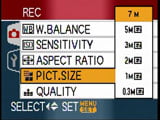 |
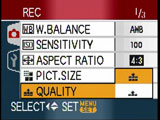 |
The FX30 offers no fewer than five lower resolutions and the choice of two different JPEG compression levels, although like most compacts, there’s no RAW mode. The FX30’s best quality JPEGs typically measure around 3MB each. There’s 27MB of internal memory to get you started, but like all cameras you should buy a memory card straightaway – like other Panasonics, the FX30 takes SD memory and is compatible with older MMC cards or newer SDHC cards for higher capacities. Note the FX30 can’t record movies on MMC cards though.
The FX30 also offers 3:2 and 16:9 aspect ratios, each available in two resolutions. Unlike the cunning sensor implementation of the Lumix TZ3 though, the FX30 simply crops horizontal bars from the top and bottom of its images to create these wider shapes. In 3:2 mode the maximum image size drops to 3072×2048 pixels, while in 16:9 it falls further to 3072×1728 pixels.
Panasonic Lumix DMC-FX30 exposure and creative options
The Panasonic Lumix FX30 offers shutter speeds from 1/2000 to 8 seconds (and up to 60 seconds in a Scene preset), along with two aperture settings at each focal length, although there’s little or no means to manually adjust them. By carefully choosing one of the 21 Scene presets and adjusting exposure compensation though you can actually achieve a wide range of creative results.
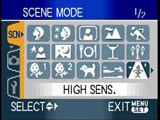 |
The 21 scene presets presented across two pages consist of Portrait, Soft skin, Self Portrait, Scenery, Sports, Night portrait, Night scenery, Food, Party, Candle light, Baby 1, Baby 2, Pet, Sunset and High Sensitivity on the first page, followed by Starry sky, Fireworks, Beach, Snow, Aerial photo and Underwater on the second. The latter is for use with the optional underwater housing, while the Baby and Pet presets allow you to overlay their ages on the picture.
By knowing the characteristics of each scene preset (detailed in the manual) it’s possible to ‘trick’ the FX30 into using preferred apertures or shutter speeds – for example, Portrait mode will select a small depth of field, Sports will opt for a fast shutter speed, and Landscape will focus on a distant subject. The Starry sky preset also allows surprisingly long exposures for a compact, offering the choice of 15, 30 or 60 seconds.
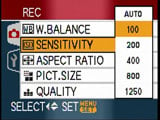 | |
Like most Lumix compacts, the FX30’s sensitivity ranges between 100 and 1250 ISO, with an ambitious 3200 ISO mode when using the High Sensitivity preset; unfortunately like other Lumix models, the image quality suffers from noise and noise reduction at higher sensitivities as can be seen in our results pages.
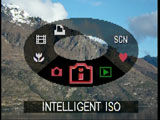 |
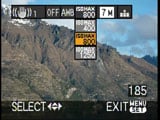 |
In line with other models in the current Lumix range, the FX30 additionally features an Intelligent ISO setting which detects motion in the frame and can automatically increase the ISO to provide a sufficiently quick shutter speed to freeze it. In practice this works quite well and you can also set an upper limit for the ISO from 400 to 1250 ISO to maintain some control over image quality.
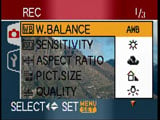 |
White balance can be set to Automatic, Daylight, Cloudy, Shade, Tungsten or a custom preset calculated by taking a reading from a specific subject. There’s no manual control over contrast, sharpness, saturation or noise reduction, but the FX30 does at least offer five colour modes to choose from: Standard, Natural, Vivid, Cool and Warm. We used the default Standard setting for all our sample and test images.
Panasonic Lumix DMC-FX30 video mode
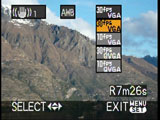 |
With the main mode dial set to the filmstrip icon you can record video clips in the Quicktime Motion JPEG format. Like other Lumix compacts, the FX30 can record in conventional 4:3 or widescreen 16:9 aspect ratios and at either 10 or 30fps.
Set to 4:3 the video resolution is either VGA 640×480 pixels or QVGA 320×240 pixels, while at 16:9 the FX30 records a genuine widescreen WVGA mode of 848×480 pixels. Video recording is not supported on MMC memory cards – you’ll need to use SD cards or the built-in memory. Note if you are using the built-in memory though, the video resolution is fixed at 320×240 pixels.
You can adjust the optical zoom before, but not during filming, and optical stabilisation is available using Mode 1. You’re looking at about 1.3MB per second of widescreen video at 30fps. The video quality, like other Panasonic cameras, is very good with only a little tearing occasionally visible when panning. It’s also nice to switch the TV output aspect ratio to 16:9 and output anamorphic video ready to be stretched out to fill a widescreen TV.
 |
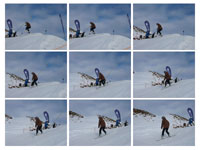 |
The FX30 also allows you to grab nine frames from a video clip and create a single image showing all as thumbnails. This can be fun for analysing motion, such as a golf swing or a ski jump. When replaying a video, simply twist the zoom lever to wide to show a series of nine thumbnail images, then use the zoom lever again to adjust the gap between consecutive frames to 1/5, 1/10, 1/15 or 1/30 of a second. Finally use the arrow keys to choose the desired series of nine frames, then press the shutter release button to capture them as a single composite image; if you recorded your video at the full VGA resolution, the final composite image will measure 2 Megapixels. See our FX30 video tour for a demonstration of this feature.
Panasonic Lumix DMC-FX30 handling
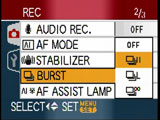 |
The Panasonic Lumix FX30 starts-up and is ready for action in about 1.3 seconds, so while it’s not the swiftest on the market at powering-up, it won’t keep you waiting for long. Like most Lumix compacts there’s a choice of continuous shooting options: High, Low and Infinity. Set to its fastest ‘High’ mode, the FX30 can take up to five best-quality or seven lower quality frames at a quoted rate of 3fps. Set to Infinity, it’ll keep taking shots while there’s memory remaining, although the quoted rate falls to approximately 2fps.
In tests with a SanDisk Ultra II 1GB SD card we set the FX30 to High mode and fired-off the five frames in 1.8 seconds, corresponding to a rate of 2.8fps. Set to Infinity mode the FX30 indeed seemed happy to keep shooting while you had memory remaining; we timed 20 frames in 9.5 seconds, corresponding to a rate of just over 2fps. Now let’s check out the FX30 optical stabilisation.




